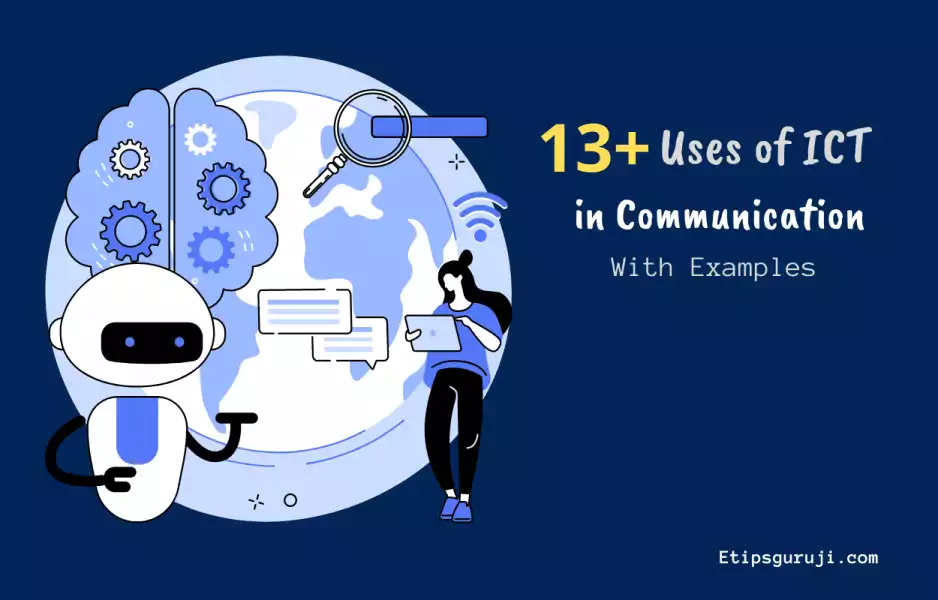13+ Uses of ICT in Communication With Examples

The term “Information and Communication Technologies” (ICTs) refers to a wide range of technologies that can connect one person or group to another.
Currently, there are a lot of ways by which one can communicate with others using wired and wireless communication. And with this post, I will discuss what are the uses of ICT in communication sector.
1. Video Conferencing
With video conferencing, one can talk verbally with active video. They don’t require specialized technology, you just have a good internet connection and apps to work with. Businesses use video conferencing to hold a meeting between groups of individuals who work from home, in various parts of the country, or even in another country.
Video conferencing has several advantages:
- Anytime any where. No need to travel.
- Saves a lot of time and a step to cause less damage to environment by saving traveling fuel.
- Meetings can be scheduled fast.
2. Mobile Communication

Mobile communication is one of the most developing technology sectors. With the evolution of smartphones and mobile networks, mobile communication is the most important part of day-to-day communication.
In simple mobile communication, a set of transmitters is used to deliver data wirelessly to another transmitter. Now, let’s take a look at different sub-sector of mobile communication.
2a. SIM
SIM is the abbreviation for Subscriber Identification Module. It is an integrated circuit to identify the owner of a mobile device by storing an International Mobile Subscriber Identification (IMSI) number.
Every Device that works wirelessly has a SIM card including regular smartphones, smartwatches, smart cameras, laptops, etc.
2b. Landlines
Landlines are outdated, but still, they work well in communicating over a smaller area such as offices. They are easy to set up in an office or small LAN area and you don’t need to pay a monthly bill for the calls that use LAN.
The technology is simple, it first ties a caller with a voice, creates an electrical signal that other receivers receive, and coverts back to voice.
2c. VOIP Voice over Internet Protocol (VOIP) Systems
A VoIP phone system uses your internet connection rather than a traditional landline or cellular network to make phone calls.
Over your internet connection, a VoIP system transforms analog voice impulses into digital ones and then connects to the receiver end to re-covert them into a voice signal.
3. Email
Email is a technique of transmitting messages from one computer to another across the internet in real-time. It uses a unique name with the ‘@’ symbol followed by the email provider.
Email usage was initially limited to users on the same system, and it required users to be connected to receive messages. Within the last decade, email also changed drastically. Now, you can send a message to several recipients using Bcc and Cc filters.
4. Multimedia Presentations

Multimedia presentation conveys information through distinct modes of communication. It includes text, graphics, animation, video, music, and interactive features such as forms, and pop-ups.
They are used extensively for presenting the data in visible form. The most common presentation softwares are Microsoft PowerPoint and Google Slides.
5. Printing flyers and Posters
Companies use posters and flyers for brand awareness and promotion. These flyers and posters are considered the most adaptable and successful marketing tools.
If done correctly, they can instantly express messages and convince the public to buy a product or service. Despite the growing popularity of digital marketing, flyers and posters are still an effective way to increase sales.
6. Websites
A website can be whatever its user wants it to be. To name a few possibilities, it could be informative, instructive, or controversial. For a general definition, a website is simply a place for a person or company to express themselves and their product and services to their audience.
Customer testimonials, reviews, and case studies are all excellent ways to show your clients your expertise. These markers increase the client’s trust and increase the chance of getting involved in your business.
7. Music Production
Music production is the process of creating, recording, editing, and preserving music so that it can be shared and enjoyed. They are made to share knowledge, information, awareness, affection, or guidance with a specific set of people.
For producing good lovable music, a music producer must have excellent listening skills and a solid understanding of recording technology, extensive musical knowledge, and excellent project leadership and management abilities.
8. Cartoon Animation

Animation is a technique for creating movable sequential pictures using computer graphic programs, drawing, models, and puppets.
When the sequence of pictures runs fast, at speed of 1/10th of a second, it seems movable to the human eye. And the number of pictures (frames) a second has is called frame per second (FPS). Early cartoons are examples of this, but nowadays, computer-generated imagery is used to create the majority of animated films (CGI).
9. Media Streaming
Streaming video and audio files require an active connection and the speed of connection determines the fluency of streaming content. Some content such as 2k videos generally require 5 to 10 MB/s of active internet connection and this number goes beyond 50 MB/s for 4k video content. There are various content providers that support streaming video including, YouTube, ESPN, Netflix, etc.
10. E-publications
E-publishing refers to any sort of digital product that can be delivered digitally such as eBooks, courses, online classes, articles on websites, projects, etc. There are several e-publishers such as for e-book: Amazon Kindle, for courses: Udemy, for news: e-newsletters and website.
11. Entertainments
Nowadays, gadgets make a person’s life easier and open a wide way to consume engaging media. You can watch the film, series in just a few clicks. With the release of apps, you can even watch TV shows anywhere without being set in front of the TV.
Digital cameras, printers, and scanners, in addition to improving graphic interfaces, have enabled more people to experiment with image and video production.
12. Medical Science

Medical equipment is advanced enough to monitor and process information about a person. Devices like smartwatches, fitness bands come with health monitoring sensors to easily process the daily health goal of an individual. They become an additional set of monitoring services than the regular medical reports.
Other than this, equipment is bundled up with a health reports database to add, retrieve, and store data for health and bio medicinal use. This ensures a better health analysis and diagnosis of disease and its treatment.
13. Finance
Financial institutions use information and communication technologies on a regular basis to exchange financial reports, results, and keep track of personal budgets.
ICT enables quick financial data calculations and provides strategic and creative benefits to financial services organizations such as electronic money transfers via cards or e-commerce, which includes online shopping and payment, among other things. ICT facilitates easy and secure money transition, legal challenges, and global access to various markets of the world.
14. Public Sector Management
ICT is used to improve the accessibility of government services, make government more transparent and accountable to citizens, and create more productive and cost-effective government policies.
This includes a variety of economic, budgetary, structural, and legal sections of government. People can also use ICT to do things like pay law enforcement bills, renew legal documents like driver’s licenses, and other online paperwork.
15. Agriculture
ICT provides a basis for communicating with innovative technologies in improving agricultural procedures and practices, especially in rural and remote areas.
Improved agricultural practices, easier access to environmental assets, efficient production plans, and marketing strategies for agribusiness or financial services are some of the advantages of ICT in the agricultural sector.
Read More:
